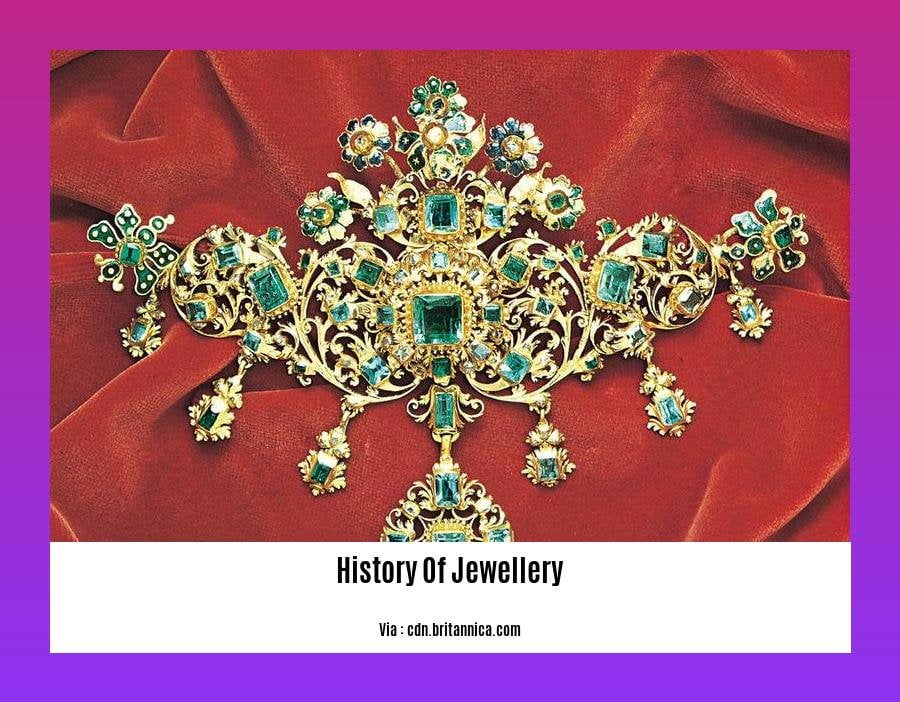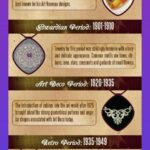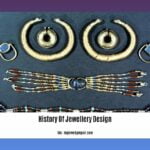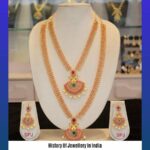Embark on a mesmerizing journey through time as we unveil the captivating history of jewelry and its profound cultural significance. Discover how adornments have transcended mere accessories to become powerful symbols of power, status, wealth, and personal expression. From ancient talismans to contemporary masterpieces, each piece holds a story waiting to be revealed. Prepare to be enchanted by the intricate craftsmanship, diverse designs, and enduring allure of jewelry throughout the ages in [A Journey Through Time: Unveiling the History of Jewelry and Its Cultural Significance].
Key Takeaways:
- Jewelry’s history spans an impressive 100,000 years.
- Between 1100 and 1400, jewelry served as a symbol of one’s social standing and wealth.
- The 17th century saw the rise of poison rings, a unique and dangerous fashion.
- In the 19th century, Victorian and mourning jewelry gained popularity, reflecting the era’s societal norms.
- The Arts and Crafts Movement left its mark on jewelry in the late 19th century, emphasizing craftsmanship and simplicity.
- To delve deeper into the fascinating history of jewelry, explore resources such as “A History of Jewellery” on The Bench and “Jewelry Making Through History” on TrueFacet.
History of Jewelry
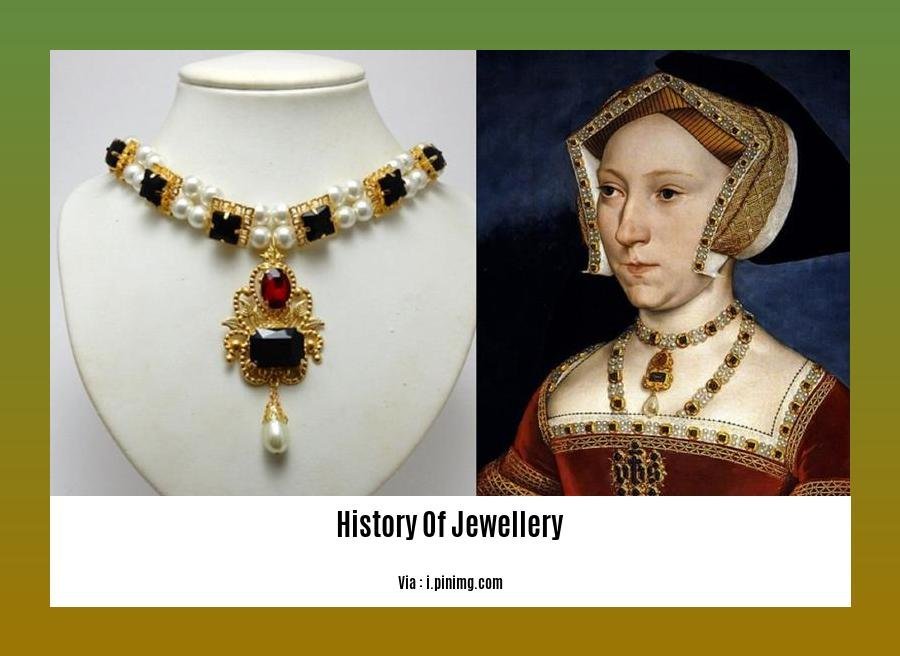
From humble beginnings to dazzling masterpieces, the history of jewelry is a captivating journey through time and cultures. Discover how adornments evolved from mere accessories into symbols of power, wealth, and personal expression.
The Dawn of Adornment
100,000 years ago, our ancestors crafted simple beads from shells, stones, and animal bones. These early adornments served not just as decoration but also as talismans, believed to possess magical protective powers.
Jewelry as a Status Symbol
In ancient Egypt, jewelry denoted social status. Gold, a symbol of the sun god Ra, was reserved for royalty and religious figures, while lesser metals and gemstones were worn by the masses.
Poison Rings and the Renaissance
During the 17th century, poison rings gained popularity, concealing a hidden compartment for deadly toxins. These rings were often used for political assassinations and covert plots.
Mourning Jewelry in Victorian Times
The Victorian era witnessed the rise of mourning jewelry, a somber form of self-expression following the death of a loved one. Jet, a black gemstone, was commonly used in these pieces, symbolizing grief and remembrance.
The Arts and Crafts Movement
In the late 19th century, the Arts and Crafts Movement championed handcrafted jewelry, rejecting mass production in favor of unique pieces made by skilled artisans.
Jewelry Today: A Reflection of Individuality
In the modern era, jewelry has transcended its traditional roles. It has become a means of self-expression, storytelling, and personal style. From bold statement pieces to delicate heirlooms, each jewel carries a unique tale, adding to the rich tapestry of human history.
A Timeless Legacy
The history of jewelry is an ongoing saga, a testament to humanity’s enduring fascination with adornment. Through the ages, jewels have adorned our bodies, mirrored our cultures, and reflected our most cherished beliefs and values.
-
Dive into the rich tapestry of history of itachuna rajbari, a testament to the enduring legacy of Bengal’s architectural heritage, and uncover the fascinating tales that echo within its walls.
-
Embark on a musical odyssey through history of italian music, where melodies intertwine with history, from the enchanting opera arias to the soulful strains of traditional folk tunes.
-
Experience the adrenaline-fueled journey of history of jaguar cars, a brand synonymous with power, elegance, and innovation, as it roars through the annals of automotive history.
Technological Advancements: Highlighting the evolution of jewellery-making techniques, from traditional handcrafting to modern mass production methods.
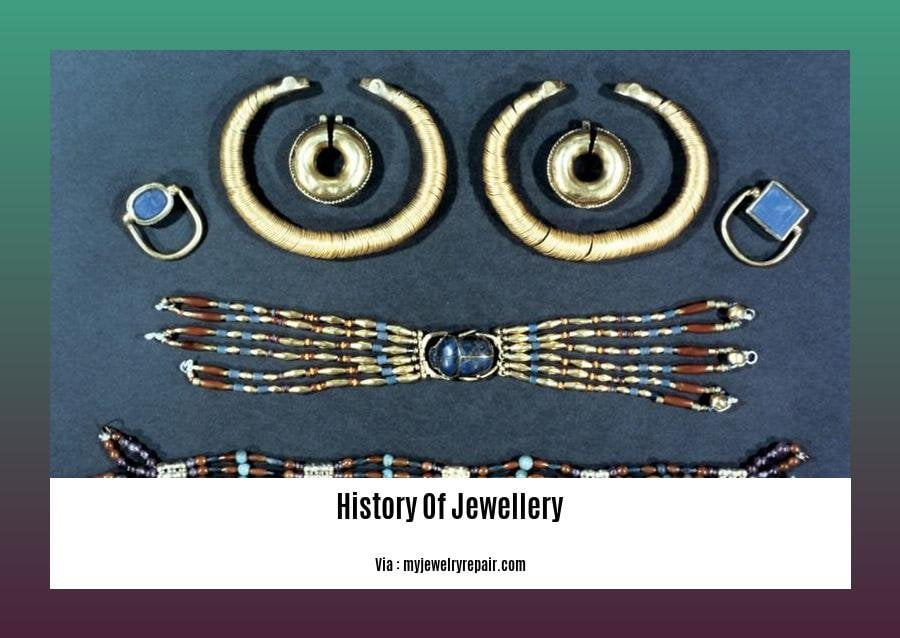
Imagine delving into the captivating history of jewelry making, tracing its intricate evolution from ancient artistry to modern-day wonders. Join us on a remarkable voyage through time, where we uncover the technological advancements that revolutionized this timeless craft.
Techniques from the Past to Today
The saga of jewelry making is a testament to human ingenuity and creativity. From the delicate handcrafting of ancient artisans to the cutting-edge techniques of contemporary designers, each era has left its unique mark on this captivating art form.
In the early days, skilled craftsmen meticulously fashioned adornments from nature’s bounty, weaving shells, stones, and animal bones into expressive pieces. As civilizations flourished, precious metals like gold and silver took center stage, allowing artisans to create intricate designs that spoke of status, wealth, and cultural identity.
The 20th century ushered in an era of mechanization, transforming the jewelry industry. Mass production methods, driven by technological advancements, made jewelry more accessible, allowing people from all walks of life to adorn themselves with beautiful trinkets.
Modern Marvels: Technology’s Role in Jewelry Making
In the realm of contemporary jewelry making, technology plays an increasingly pivotal role. From design to production, cutting-edge tools and techniques are redefining the boundaries of creativity and craftsmanship.
Computer-Aided Design (CAD): Precision at Your Fingertips
CAD software has revolutionized the design process, enabling jewelers to create intricate and detailed designs with unmatched accuracy. From sketching to rendering, CAD streamlines the design phase, allowing jewelers to visualize and refine their ideas before crafting the physical piece.
3D Printing: From Concept to Creation
3D printing technology has opened up new avenues for jewelry production. By translating digital designs into tangible objects, 3D printers create intricate pieces with complex geometries that would be challenging or impossible to achieve using traditional methods.
Laser Cutting and Engraving: Precision and Artistry United
Laser technology has brought a new level of precision to jewelry making. Lasers can cut intricate patterns with unmatched accuracy, allowing jewelers to create delicate and detailed designs that were previously impossible to achieve.
The Future of Jewelry Making: Where Innovation Meets Tradition
As technology continues to advance, the future of jewelry making holds endless possibilities. We can expect to witness further integration of technology, blending seamlessly with traditional craftsmanship.
Imagine trying on virtual jewelry using augmented reality (AR), customizing designs in real-time, or even printing unique pieces using sustainable biomaterials. The possibilities are truly boundless.
Key Takeaways:
-
Technological advancements have revolutionized jewelry making, from ancient handcrafting to modern mass production methods.
-
CAD software and 3D printing have transformed the design and production processes, empowering jewelers to create intricate and detailed pieces with unmatched precision.
-
Laser cutting and engraving bring a new level of precision and artistry to jewelry making, allowing for intricate patterns and delicate designs.
-
The future of jewelry making holds exciting possibilities, with technology seamlessly blending with traditional craftsmanship to create innovative and sustainable designs.
Relevant Sources:
-
The History of Jewelry Making: From Ancient Times to the Present Day
Changing Aesthetics: Discussing the shifts in jewellery design throughout history, influenced by artistic movements, societal changes, and technological advancements.
Key Takeaways:
- Artistic movements have had a profound impact on jewelry design. From Art Deco to Modernism, each era has left its mark on the aesthetics of jewelry.
- Societal changes such as the rise of the middle class and the women’s suffrage movement have also influenced jewelry design.
- Technological advancements have enabled jewelers to create new and innovative designs. For example, the invention of the laser cutter has made it possible to create intricate designs with precision.
1. Artistic Movements:
Artistic movements often dictate the aesthetics of jewelry that are popular at that time. Each era has its own artistic movement that influences the design of jewelry. For example:
– Art Deco: This movement emphasized geometric shapes and bold colors. Jewelry from this era often featured sharp lines and angular shapes.
– Modernism: This movement rejected traditional forms and embraced simplicity and functionality. Jewelry from this era was often made from simple, clean lines and geometric shapes.
– Postmodernism: Jewelry from this saw the return of traditional forms and emphasized irony, playfulness, and eclecticism.
2. Societal Changes:
Societal changes can also have a significant impact on jewelry design. For example:
– The rise of the middle class: As the middle class grew in size and wealth, they began to demand more affordable jewelry. This led to the development of new designs and materials, such as gold-filled jewelry.
– The women’s suffrage movement: The women’s suffrage movement led to an increased demand for jewelry that was both stylish and practical. This led to the development of new designs, such as the suffragette brooch.
3. Technological Advancements:
Technological advancements have also had a major impact on jewelry design:
– The invention of the laser cutter: The laser cutter has made it possible to create intricate designs with precision. This has led to the development of new and innovative jewelry designs.
– 3D printing: 3D printing is a relatively new technology that is being used to create custom jewelry. This technology allows for the creation of complex and unique designs.
Conclusion:
Jewelry design has been shaped by a variety of factors, including artistic movements, societal changes, and technological advancements. By understanding these factors, we can better appreciate the history of jewelry and its role in our culture.
Source:
1. Timeline of Jewelry History
2. The History of Jewelry Design
Contemporary Trends: Examining the Current Landscape of the Jewellery Industry, including the Rise of Sustainable Practices, Personalization, and the Fusion of Traditional and Modern Designs.
In the ever-evolving world of jewelry, the industry is witnessing a cascade of contemporary trends that echo a paradigm shift toward sustainability, personalized experiences, and the harmonious fusion of traditional and modern design aesthetics.
Key Takeaways:
-
Sustainability: Driven by eco-conscious consumers, the industry embraces sustainable practices, incorporating recycled metals, ethically sourced gemstones, and lab-grown diamonds.
-
Personalization: Catering to a discerning clientele, jewelry designers create bespoke pieces, allowing customers to express their individuality through unique designs.
-
Fusion of Styles: The industry witnesses a fusion of traditional craftsmanship with cutting-edge technology, resulting in captivating designs that blend the best of both worlds.
Sustainability Revolution:
Aligning with the growing consciousness of environmental responsibility, the jewelry industry is embracing sustainability in myriad ways:
-
Recycled Metals: Artisans craft jewelry from recycled gold, silver, and platinum, reducing the environmental impact of mining and preserving natural resources.
-
Conflict-free Gemstones: Ethical sourcing practices ensure that gemstones are procured from conflict-free zones, supporting fair trade and benefiting local communities.
-
Lab-grown Diamonds: These diamonds, identical to their mined counterparts, are produced in controlled laboratory environments, offering a sustainable alternative without compromising brilliance and quality.
Personalization: Empowering Individuality:
In an era of self-expression, personalization has become a defining trend in the jewelry industry:
-
Custom Designs: Skilled jewelers create one-of-a-kind pieces tailored to the customer’s preferences, allowing them to tell their stories through unique adornments.
-
Engraving and Inscriptions: Personal messages, names, or significant dates are engraved on jewelry, transforming them into sentimental treasures.
-
Birthstone Jewelry: Gemstones corresponding to birth months are incorporated into jewelry, creating meaningful pieces that celebrate individuality.
Fusion of Styles: A Tapestry of Traditions and Innovation:
The contemporary jewelry landscape is characterized by a harmonious fusion of traditional and modern design elements:
-
Traditional Techniques: Artisans revive ancient techniques like granulation, filigree, and enamel work, creating intricate pieces that honor cultural heritage.
-
Modern Materials: Contemporary designs experiment with unconventional materials such as titanium, carbon fiber, and ceramic, pushing the boundaries of creativity.
-
Digital Design: Technology enables designers to create complex and precise designs using CAD software, bringing innovative concepts to life.
Conclusion:
The jewelry industry is redefining its identity through sustainability, personalization, and the fusion of traditional and modern designs. Sustainability addresses the ethical and environmental concerns of conscious consumers. Personalization caters to the desire for unique expression. The fusion of styles blends the timeless elegance of tradition with the dynamism of innovation. These trends are not just fleeting fads but transformative forces shaping the future of the industry, ensuring it remains vibrant, inclusive, and relevant in the years to come.
Relevant Sources:
[1]
[2] https://www.bain.com/insights/digital-transformation-in-the-jewelry-industry/
FAQ
Q1: When did the history of jewelry begin?
A1: The history of jewelry can be traced back to approximately 100,000 years ago, with evidence of shell beads and other adornments from the Middle Stone Age.
Q2: What was the significance of jewelry in the 14th century?
A2: During the 1100-1400 period, jewelry held great importance as a symbol of status and wealth, serving as a visual representation of one’s social standing and economic power.
Q3: What was the purpose of poison rings in the 17th century?
A3: In the 17th century, poison rings were prevalent, featuring a concealed compartment that could hold a small amount of poison. These rings were used for discreet assassinations or self-defense in a time of political intrigue and power struggles.
Q4: What was the trend in jewelry during the Victorian era?
A4: The Victorian era witnessed the rise of mourning jewelry, which served as a tangible expression of grief and remembrance for departed loved ones. These pieces often incorporated elements such as black enamel, jet stones, and hair from the deceased.
Q5: How did the Arts and Crafts Movement influence jewelry design?
A5: The Arts and Crafts Movement, which emerged in the late 19th century, had a significant impact on jewelry design. It emphasized handcrafted artistry, natural forms, and the use of semi-precious stones, rejecting the mass-produced, ornate styles that were popular at the time.
